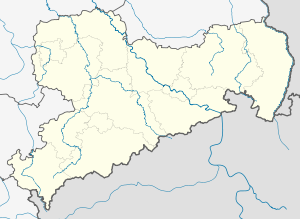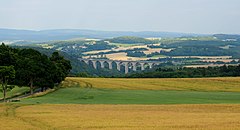Elstertalbrücke (motorway)
Coordinates: 50 ° 25 ′ 42 ″ N , 12 ° 4 ′ 15 ″ E
|
|
||
|---|---|---|
| Official name | White Elster valley bridge Burgstein-Pirk |
|
| Convicted | Federal motorway 72 | |
| Subjugated |
White Elster , Plauen – Cheb railway line |
|
| place | Weischlitz OT Pirk | |
| Building number | 104 | |
| construction | Arch bridge / girder bridge | |
| overall length | 503.5 m | |
| width | 2 × 14.75 m | |
| Longest span | 38.5 m | |
| Construction height | 2.5 m | |
| height | 60 m | |
| building-costs | 69 million DM | |
| start of building | 1938/1991 | |
| completion | 1993 | |
| opening | September 6, 1993 | |
| location | ||
|
|
||
| Above sea level | 420 m above sea level NN | |
The Elstertalbrücke Pirk is one of the largest stone arch bridges in Europe that was built for road traffic. It is part of the federal highway 72 and is located at highway kilometer 23.7 in the low mountain range of the Vogtland near Pirk , a district of Weischlitz . Construction of the bridge began in 1938, but work stopped in 1940 due to World War II . The bridge remained unfinished for 50 years before it was completed after German reunification in 1990.
history
During the construction of the Leipzig – Hof railway line, two large brick bridges, the Göltzschtalbrücke and the Elstertalbrücke, had to be built in the Vogtland between 1846 and 1851. The Reichsautobahn Chemnitz – Hof was also led through the landscape characterized by deep valley cuts. Again, the Göltzsch valleys had to be spanned by a motorway bridge at Weißensand and the valley of the White Elster . The motorway bridge over the Elstertal was planned from 1936 as the largest solid road bridge in the world with a total length of 623.7 m and a maximum height of 60 m. The construction costs should amount to 12 million RM .
Construction work began in 1938. The construction site worked 24 hours a day in two shifts. A total of about 450 workers were employed, the executing companies were Philipp Holzmann , Grün & Bilfinger and Wayss & Freytag . Walter Kinze (1910–1994) was the chief engineer for bridge construction, and from 1960 professor for foundation engineering at the Technical University of Dresden . Due to the Second World War , the building could not be fully completed. In 1940 construction work ceased. By then the twelve arches had been completed, the masonry and the roadway were still missing.
After the division of Germany , the bridge was on the edge of the GDR's restricted border area and remained a fallow construction site for around 50 years.
Preliminary investigations began in June 1990 and further construction was finally initiated in September 1990. The aim was to preserve and use the existing substance as much as possible; Even the granite blocks that had been stored nearby for decades could be used for the facing masonry. The engineering office of Prof. Dr.-Ing. Bechert & Partner in Stuttgart. The technical office of the Munich head office of the construction company Dyckerhoff & Widmann carried out the execution and structural planning . The construction work was carried out by a joint venture from the Nuremberg branch of Dyckerhoff & Widmann and the Munich company Kunz GmbH & Co. , the cleaning and grouting work on the old building was carried out by the Nuremberg company Rödl GmbH . The bridge's northern lane was opened to traffic on October 2, 1992, and the southern lane followed on September 6, 1993.
construction
The structure, which is up to 60 m high, has eleven pillars that taper slightly towards the top and twelve 18.28 m wide arches, each with 33.5 m clearance. The excavation pits for the pillar foundations were up to 8 m deep. Yellowish and bluish granite stone was used , which was bricked in regular layers. A total of 20,000 m³ of ashlar masonry was tendered for the vaults and cladding. The pillars consist of a granite wall and a core made of stamped concrete .
Today, the bridge only appears to be an arched bridge, as the original structural system was no longer used for the superstructure. To ensure that the arches remain unloaded, a modern continuous girder construction made of prestressed concrete was used for the superstructure (prestressed concrete hollow boxes for each direction of travel, 2.5 m high and 29.5 m wide together). This means that the loads are diverted directly into the pillar axes via support chairs. On the other hand, the original width of the bridge crown, which was set at 19 m according to the normal profile of the Reichsautobahn , could be widened on both sides by about 5.25 m to a total of 29.5 m through the prestressed concrete deck. Compared to the original planning, this overhang enabled two lanes and one hard shoulder for each direction of travel. In the bridge area, the highway route to the northeast increases by 2%.
Today the bridge has a total span of 503.5 m. The new superstructure has bay widths of 17.0 m, 33.0 m, 10 × 38.5 m, 35.0 m and 33.5 m. The structure is a total of 505.5 m long and 60 m high above the White Elster.
Josef Scheidler, head of the tunnel and bridge construction department in the highest building authority of the Free State of Bavaria, had been instrumental in maintaining and completing the bridge, despite the significantly higher costs compared to a new construction. A memorial plaque was placed at the foot of the seventh pillar in his honor.
Granite cuboid as a building material for the bridge piers, 2015
Federal highway 173 turning before the bridge, 2016
Quotes
"The most beautiful bridge shape for high valley bridges is the arch on slender pillars with the same opening widths up to the ends of the bridge that fade into long cheek walls."
"This bridge is a symbol of the growing together of the two German states."
literature
- Federal Ministry of Transport: Bridges on the federal trunk roads 1994 . Verkehrblatt-Verlag Dortmund, ISBN 3-89273-070-9 , pp. 35-46.
- Hans-Dieter Pfeiffer, Joachim Schmiedel: Weisse-Elster Valley Bridge Pirk. In: Stone bridges in Germany. Verlag Bau + Technik, 1999, ISBN 3-7640-0389-8 , pp. 242–245.
- Jean-Curt Röder: The Pirker Autobahn Bridge. In: Vogtländisches Jahrbuch , 10th year, Plauen 1993, ZDB -ID 913130-9 , pp. 10-11.
Movie
- The Pirk motorway bridge - from the unfinished to the unified symbol. Documentary, Germany, 2015, 29:43 min., Script and director: Ina Klempnow, production: MDR Sachsen , series: Der Osten - Discover where you live , first broadcast: March 31, 2015 on MDR television , synopsis by MDR, ( Memento from April 2, 2015 in the Internet Archive ), online video available until November 10, 2020.
Web links
- Elstertalbrücke (motorway). In: Structurae
- Photo with the memorial stelae in front of the bridge. In: vogtland89.de , September 6, 1993
Individual evidence
- ↑ a b Renate Wöllner: Bridge as a symbol of unity. ( Memento from April 2, 2015 in the web archive archive.today ). In: Frankenpost , October 5, 2012.
- ↑ a b c The Pirk motorway bridge - from the unfinished to the unified symbol. ( Memento from April 2, 2015 in the Internet Archive ). In: MDR , March 31, 2015.
- ↑ Photo of the unfinished bridge. In: Autobahn-Online , 1990.
- ^ Karl Schaechterle, Fritz Leonhardt : The design of the bridges. Volk und Reich Verlag, Berlin 1937, DNB 361676514 .
- ^ Peter Albrecht: The publisher celebrates twice today. In: Freie Presse , March 26, 2015, only the beginning of the article free.







